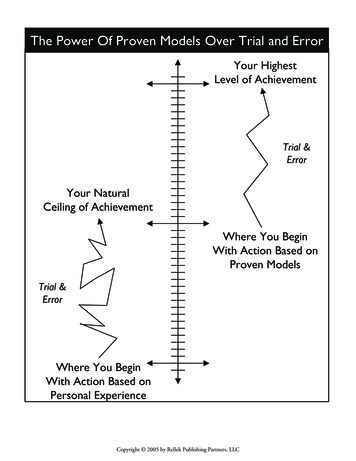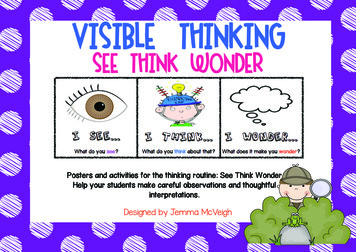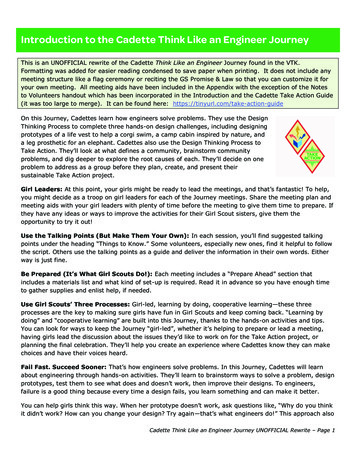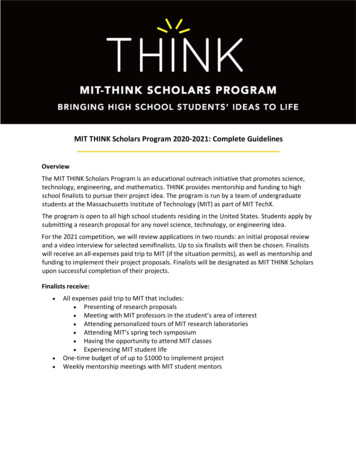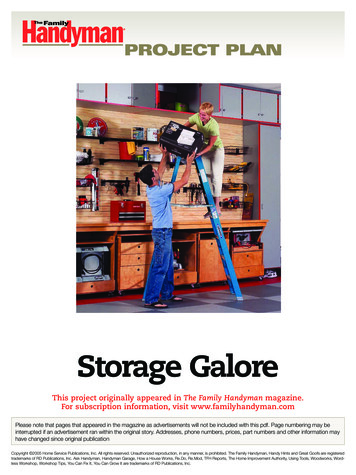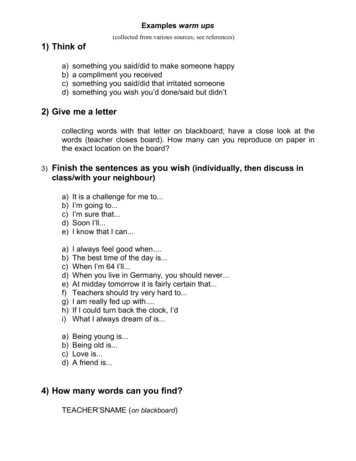
Transcription
Examples warm ups(collected from various sources; see references)1) Think ofa)b)c)d)something you said/did to make someone happya compliment you receivedsomething you said/did that irritated someonesomething you wish you’d done/said but didn’t2) Give me a lettercollecting words with that letter on blackboard; have a close look at thewords (teacher closes board). How many can you reproduce on paper inthe exact location on the board?3)Finish the sentences as you wish (individually, then discuss inclass/with your neighbour)a)b)c)d)e)It is a challenge for me to.I’m going to.I’m sure that.Soon I’ll.I know that I can.a)b)c)d)e)f)g)h)i)I always feel good when.The best time of the day is.When I’m 64 I’ll.When you live in Germany, you should never.At midday tomorrow it is fairly certain that.Teachers should try very hard to.I am really fed up with.If I could turn back the clock, I’dWhat I always dream of is.a)b)c)d)Being young is.Being old is.Love is.A friend is.4) How many words can you find?TEACHER’SNAME (on blackboard)
Examples warm ups(collected from various sources; see references)5) AssociationsStart by suggesting an evocative word: ‘storm’, for example. A student sayswhat the word suggests to him/her - it m–ght be ‘dark’. The next studentsuggests an association with the word ‘dark’, and so on round the class. Ifthere is time, after you have completed a chain of about 15-25associations, take the final word suggested, write it on the board, and,together with the class, try to reconstruct the entire chain back to theoriginal idea.16) Reduce sentencea student to come to the board and draw a woman looking at awindow ledge three storey up – her son is crawling along the ledgea)ASKb)WRITEon bb: Anne came down the stairs and crossed the courtyardwhen suddenly she looked up and saw her tiny son in his browndungarees crawling along the kitchen window ledge: she was just intime to catch him when he fell. (The beautiful and very tall lady was singinga good old song from former times and in doing so she looked flirtatiously atthe incredibly handsome man who was sitting across from her at the oak tablenext to the loo and who was listening to her extremely attentively whiledrinking a large pint of Lager.)c)the sentence to one word. In any one go you may take out up toand including three consecutive words!REDUCE7) Abstract pictureDraw a big rectangle on the board. Draw in the rectangle a variety ofsquiggles (Schnörkel), doodles (Gekritzel), shapes, and colours. Ask theclass what they think the picture represents. Use your imagination, there’sno right or wrong!8) Correcting mistakesWrite grammatically or lexically incorrect sentences on blackboard and askstudents to spot/correct the mistakes.9) How many things can you think of that.?
Examples warm ups(collected from various sources; see references). are small enough to fit into a matchbox?. are bigger than you are?. are round?. are long and thin?. make a noise?. people enjoy looking at?10)It was the way she said itTake one word or short sentence and ask the students to say it in as manydifferent ways as possible. Discuss what difference the intonation makes tothe meaning in each case, or in what circumstances this intonation mightbe useda)b)c)d)e)f)g)h)i)j)11)12)I love you.OhHelloGood morningWellCome herePleaseYouYesNoJumbled words/sentencesDescribe your neighbour (requires even number of students!)Divide the class into pairs. Give each student the letter A or B. Tell thestudents A to close their eyes and put their heads on their arms or desk.Tell the A students that they should now try to describe their neighbour B’sappearance to him or her from memory. B should help by asking questionsand commenting.If there is time, reverse roles and student B should try to describe the frontand back of the classroom (or the teacher’s appearance).
Examples warm ups(collected from various sources; see references)13) New comparisonsTeach the class a few ‘as.as’ similes commonly used, then suggest a fewadjectives, and ask them to invent their own comparisons.Conventional similes: as proud as a peacock, as good as gold, as warm astoast, as white as snow, as quick as lightning, as sweet as honey, as coldas ice, as light as a featherAdjectives:a) happy, long, short, beautiful, clever, clean, tall, small, rich, strongb) free, lazy, wise, powerful, innocent, ugly, smooth, faithful, fresh,colourfulc) juicy, graceful, brilliant, humble (demütig), irritable, sly (listig), rotten,romantic, obstinate, delicious14)What are they talking about?Write a sentence on the board in inverted commas; this represents a bit ofa conversation that has been overheard. The students guess what theperson is talking about and anything else they can infer about the situation(what sort of person the speaker is, relationship between speaker andhearer)The students’ solution can be presented through dramatisation: thestudents act through the situation in which the utterance occurred:a)b)c)d)e)”You idiot! We’ll never get it back now!”“I don’t approve, but if you must, you must.”“I can’t afford to, after what John’s done.”“Found it at last! But it is too late now.”“You can’t? Well, we’ll just have to manage without.”
Examples warm ups(collected from various sources; see references)15) What has just happened?Write a series of exclamations on the board (not more than ten). In pairs orgroups, students choose an exclamation, think of an event which mighthave caused someone to say it, and write down a brief description of theevent, using the present perfect (e.g. “What?” – Someone hasn’t heardwhat was just said.)Then they choose another and do the same again. After two minutes, invitestudents to read out their sentences without identifying the exclamationsthat gave rise to them; the rest of the class guesses what the exclamationswere.Oh!I’m sorry!No!Never mind!Goodbye!Ouch!16)Oh?Great!Thanks!It’s a deal!Thank goodness!Bad luck!Congratulations!What?Welcome!Hello?Yes, of course!Are you serious?Spontaneous responseTeacher: „I‘ll say something to you. It could be anything. Try to understandthe situation or context behind what I’m saying, because you are to saysomething in response that makes sense and fits in. Don’t just say ’Yes‘ or‘no‘ or ‘what?‘, because you want to show what you can do in English. Imight say, for instance,: ‘Let’s play football‘. You could say in return: ‘That’sa good ides‘ or: ‘But I want to watch TV.’, or: ‘Can’t you see I’m doing myhomework.‘ Or: ‘All right. I’ll be ready in five minutes. (evtl. vorher ein Malmuttersprachlich durchspielen: ‚Mensch, das ist aber ärgerlich!‘ e.g.: You know, Peter had an accident; can you carry this bag for me,please; last year, I made a birthday cake for my mother evtl. Ball aufnehmen und Gespräch weiterführen17)Buzz readingAs warming up activity the students start with a well-known text that theyare told to read aloud all at the same time at individual speeds:Read aloud all at the same timeRead half loud only, you may cover your earsJust mutter, and move your lips; I must see your lips movingEveryone at their own speed/at individual speeds
Examples warm ups(collected from various sources; see references)18) Total physical response In winter, when tangerines are inexpensive, every student gets one and isasked to do the following:1. Look at the tangerine and marvel at it2. Take a smell at it.3.Weigh it in your hands.4. Throw it in the air and catch it again.5. Swap with your neighbour.6. OK, lets start peeling it: press your thumb into the peel and slowly peel the tangerine7. Lay the peel on one heap to the right of you.8. No, to the left of you.9. Actually, put it in front of you.10. Peel away the white skin that we don’t like to eat.11. Now pick the tangerine to pieces, one piece after the other12. Put the pieces on the table.13. Arrange the pieces into a star.14. Now build a circle.15. Now build a rectangle.16. Offer one piece to your neighbour. Say “Here you are”. Say “Thank you” Say: “You’rewelcome”17. Let’s eat! We also might include the clothes:1. Let’s stand up again.2. Everybody who is wearing socks shake their head.3. Push down your socks and pull them up again.4. Everybody who has a belt on stand on one leg.5. Everybody who has a cardigan/jacket on sit down.6. Does your cardigan/jacket have buttons? Shout „yes“.7. Does your cardigan/jacket have a zipper instead? Shout „yes“.8. Then zip it and zip it up again(unbutton it and button it up again).9. Roll up your sleeves and roll them down again, etc.10. Everybody wearing a blue pullover, carefully pull your neighbour’s ear11. Everybody walk on the spot and wave your hands12. Those whose birthday is in May climb on the chair and down again
Examples warm ups(collected from various sources; see references)13. now: everybody: make five knee-bends14. Those wearing a turtleneck walk around your neighbour15. Take a deep breath16. Shake your heads17. All together: clap your hands and shout out loudly. I’m fit now! Sit down. The following activity requires some courage:-- -Jessica, turn to Tom in the first row here. Stare hard at him (rememberwhat the teacher sometimes does with you). Stick your tongue out athim. (Tom, just keep quite, don’t do anything). Threaten him with yourfist. Be friendly again. Wave at him with your left hand and smile. Pick upan imaginary glass from the desk and say ”cheers” to Tom.Meanwhile all other students might note down all verbs (and put theminto the past tense).Morning Exercises:“Total physical response” #1Wake up in the morning.Get up.Stretch.Put on your clothes.Walk slowly to the bathroom.Brush your teeth.Walk to the kitchen.Make some coffee.Look for bread.Complain – there isn’t any!Find an apple.Bite the apple – mmm!Put on your coat.Finish the apple.Throw the core into the waste bin.Ah – you missed!Open the front door.Go out.Close the door.-Total physical response” #2Walk down the street.It’s raining.It’s windy.Walk to the sea.Look out over the sea.It’s raining.It’s windy.Find your boat on the beach.Walk to your oat.Push your boat into the water – it’s heavy!Quick, jump into your boat.It’s raining.It’s windy.The book’s rocking.Ooh – your feel a bit sick!The storm’s getting worse.The boat rocks to the left!The boat rocks to the right!Be careful – here’s a big wave!Oh no! The wave knocks you into the water.Swim – try to get back to the boat.Watch the boat move away!Look around – you are on your own!Swim!Swim. You’re getting tired.It’s getting dark.You’re cold.You’re frightened.You can see a light! Hurray!Swim for the light.Walk onto the dry land.Run around and shout – you’re saved!Sit down and sleep!-“Total physical response” #3Wake up.Try to remember where you are.Look around – it’s a beach.Remember the boat – and the swimming!Look more carefully – there’s a small village.Walk towards the village.Creep quietly into the village.Push open a door.Peep inside.Tiptoe over to the kitchen.Notice the food.Feel very hungry.Take a piece of cheese – mmm!Hear someone come in the door.Decide whether to hide.Too late! Cover your ears – they’re screaming.Run – they’re chasing you!Try to explain who you are.Stop running.It’s OK – they believe you.Shake hands.Sit down.Have a drink.Have a meal.Relax.Go out.Get in a car.Someone is driving you home.Hurray! You are safe back home.Undress.Get into b ed.Fall asleep.Dream about the sea.
Examples warm ups(collected from various sources; see references)19) Schlangenfresser (suitable for outside!)The whole class gets up and comes to the front where they are divided intotwo equal groups each forming a line which faces each other. The teacherasks words and small phrases in German and the front player of each linehas to shout the English equivalent out. Both have then to go to the end ofwhichever line shouted the correct answer first.20)What I don’t know or do, but would like to know or do!Everybody (including teacher) jots down a few sentences.21) Hard sellIn pairs, think of arguments to persuade people to buy these objects, e.g.empty coke bottle – You could use it as a vase.a snowball, a dirty comb, one sock, a used teabag, a broken plate, cold fishand chips, a clock with no hands, a house with no roof, a bucket with ahole, a piece of string
Examples warm ups(collected from various sources; see references)22) Well, do you know your classmates?Do you know your classmates? What do you think, are these statementsright wrongright or wrong?1. Most students in this class prefer cats to dogs.2. At least half the class has seen “Borat”.3. Most students in this class have more than one brother or sister.4. Most students in this class watch more than 10 hours of TV a week.5. Most students in this class have more than one Christian name.6. There is someone in this class who almost always gets up at half pastfive.7. At least half the class enjoys going to school.8. Most students in this class like strawberry-flavoured ice-cream.9. Only one person in this class has been to Sweden.10. No one in this class has ever broken their leg.11. Most people in this class used to have a teddy bear.12. Most students in this class believe that learning Latin is useless.Do you know your classmates? What do you think, are these statementsright or wrong?1. Most students in this class like cats better than dogs.2. Most students in this class have more than one brother or sister.3. Most students in this class watch more than 10 hours of TV a week.4. Most students in this class have more than one forename.5. There is someone in this class who almost always gets up at half pastfive.6. At least half the class likes going to school.7. Most students in this class like chocolate ice-cream.8. Only one person in this class has been to England.9. No one in this class has ever broken their leg.10. Most people in this class had a teddy bear as a child.right wrong
Examples warm ups(collected from various sources; see references)23) Picture dictationDer Lehrer beschreibt ein Bild, die Schüler malen es währenddessen. ZumSchluss wird das Original auf Folie gezeigt. Garantierte Lacher.24) Five wordsJeder Schüler bekommt einen Zettel und notiert sich FÜNF verschiedeneWörter (davon höchstens ein Name). Entweder man tauscht nun den Zettelmit dem Nachbarn oder der Lehrer sammelt alle Zettel ein, mischt sie undverteilt sie bzw. lässt sie ziehen. Die Aufgabe besteht darin, aus den fünfWörtern eine lustige, dramatische, alberne etc. Geschichte zu erzählen. Jeweniger die Wörter miteinander zu tun haben, desto schwieriger wird es,desto kreativer und damit interessanter sind dann aber auch dieGeschichten. Nach einer entsprechenden Bedenkzeit nennt man, bevorman anfängt, zuerst die fünf Wörter, die dann auch in der Geschichte extrabetont werden.25) My world map- Make A4 or A3 copies of a world map, one per student.- Make a list of 10-15 nouns to use in the dictation (from concrete toabstract)- students write words in the map where they think they belong to- in pairs or threes students finally compare and discuss their placements26) Flash the picture1.2.3.4.5.6.Flash or show the picture for a very short time – a second or less.Ask students to say what they saw.Repeat steps 1 and 2.Show the picture for three or four seconds.Repeat step 2.Display the picture and keep it in full view: elicit comments: What isshown? What is it for? What has just happened? What is going tohappen? Peoples motives for what they are doing? Personalassociations?, etc.
Examples warm ups(collected from various sources; see references)27) Tongue twisters1. Give papa a cup of proper coffee in a copper coffee cup.2. Swan swam over the sea,Swim, swan, swim!Swan swam back againWell swum, swan!3. Which wristwatches are Swiss wristwatches?4. She sells sea shells by the sea shore.The shells she sells are surely seashells.So if she sells shells on the seashore,I'm sure she sells seashore shells.28) Cartoon discuss a cartoon relating to current affairs 9) Letter on the board1.2.3.4.5.6.Ask a student to pick a letter between A and Z (but not X). If the studentsays S (or whatever), write a large S on the board.Ask the students to give you five nouns that start with S. Write these nounson the board.Pair the students up (one or more threesome is ok) and ask them to decidewho is A and who is B.Tell them that in minute each A has to choose one of the topics on theboard and talk about it to their partner for 30 (60) seconds. Tell them theyshould not worry about grammatical accuracy. They should say anythingthat comes to their mind even if it is just odd words and phrases. If A getsstuck, b can prompt with questions and suggestions.Call START. Stay at the front and time 30 (60) seconds. Then call STOP.Swap roles
Examples warm ups(collected from various sources; see references)30) Camping tripYou need at least two people who already know how to play the game. Playbegins by one person saying "I'M GOING ON A CAMPING TRIP AND I'MGOING TO BRING.(at this point the person talking picks anything s/he wouldlike to bring on the trip. Let's use a sleeping bag as an example) A SLEEPINGBAG". The next person says "I'M GOING ON A CAMPING TRIP AND I'MGOING TO BRING.(at this point the person talking picks anything s/he wouldlike to bring on the trip, but it must begin with the letter "G", since the last letterof the first person 'camping accessory' was a "G". For example let's say thesecond person wanted to bring a "GUARDIAN" they can bring that soeveryone says "OKAY YOU CAN BRING THAT ON OUR CAMPING TRIP".Say the third person hasn't caught on to the game yet and says, "I'M GOINGON A CAMPING TRIP AND I'M GOING TO BRING HOT DOGS". Everyoneshould say, "NO, YOU CAN'T BRING HOT DOGS" and play continues to thenext player until everyone has caught onto the game.VARIATION:Also can be played with a different 'rule' each time. One player makes up arule, and then says something like: "I would take apples but not potatoes" Theother players then try to figure out the rule. It will take several different clues: "Iwould take a Corvette but not a Camaro" "I would take beer but not Coke" etc.Once a player thinks they have figured out a rule, they ask the first playerwhether or not they would take a certain item to verify their idea: "You wouldtake Fruit Loops but not Corn Flakes, right?" "Right" Play continues untileveryone gets the rule figured out. Then someone else picks a rule and a newgame begins. The rules can be anything, and are only limited by the creativityof the players.[P.S. the rule in this example was double letters]
Examples warm ups(collected from various sources; see references)31) Milling/market place Walk about the room. Whenever the music stops, talk with the person next toyou about the following:elementary What do you like best about being in school? How important are clothes for you? Do you believe in aliens? What is your favourite pop singer? What is your dream job? Which famous person would you like to meet? Why? Name three things that make you happy. What is your favourite subject? What makes you really angry? What is the last movie that you saw?advanced: What was or is your favourite book? What is it about? What do you likein particular about it? What are the disadvantages of being young? What is the best way to improve your English? If you could have lunch with anyone in the world, who would youchoose? Would you like to live in America? Why 8not)? Name three things that make you happy. What are you good at? What gets you really angry? Who was the best teacher that you have ever had. Why? Do you think life was better or worse in the past? Are you an optimist or a pessimist? Give examples. Is there ver an excuse for crime? What stories have been in the news recently? Tell your partner about a time something good happened to you. Tell your partner about a time something terrible happened to you. What personality trait do you respect in others? What makes a good presentation? Do you think people are basically cruel or kind? Do you believe that war is ever justified? What problems do celebrities face? Weitere “discussion topics” findet man z.B hier: Conversation Questionsfor the Classroom http://iteslj.org/questions/.
Examples warm ups(collected from various sources; see references)32) Finding connectionstalk to your neighbour and find out what you have in commonwhat do these things have in common? (a wedding and an ant; a snowflakeand a coin; the number 25 and the colour purple; name of a student and thePresident of the United states)33) Pair work: ordering activity Hand out picture story with the respective sequences being jumbled up:Discuss with your neighbour what goes where.34) Use your imagination: the lost buttonPreparation: Select a variety of buttons including plain, fancy, brass, andplastic. You will need about five more buttons than you have students inyour class as well as a strong bag for storage. In class, the students pass around the bag and select a button. Ask the students to close their eyes and imagine: The buttonThe garmentThe ownerThe loss of the buttonIt is important not to prompt; the results will be hopelessly derivative of yourexample if you do.35) Spot the mistake Students receive nearly identical pictures and by describing the scenes toeach other have to find the differences in the picture36) Jigsaw puzzle Pictures a cut into four pieces. Each student gets on piece. The studentsmust study their piece of picture and then talk to other students and find outwho has pieces of the same picture. Finally they should put all their piecesof picture together to make the whole picture.
Examples warm ups(collected from various sources; see references)37) Stranger on the trainThis activity promotes oral fluency practice & specific oral languagepractice at the same time: Get the students to imagine they are strangers ina train compartment - get them sitting opposite each other in groups of four.Elicit what people usually talk about on the train – the weather, where theyare going/coming from etc. Tell them you are going to give them a line tomemorise & that it's secret – give them out, students memorise & you takethem back in. Then explain what they have to do - to say their lines asnaturally as they can in the conversation without the others guessing it istheir line. So they have to direct the conversation so that they can say theirline naturally, without the others noticing. They must have one conversation& not split into two as the others will miss their lines when they come to saythem. The lines you give them could contain a language item that you haverecently been looking at or off-the-wall sentences (e.g. My girlfriend sleepsin the garden). when I first started learning Spanish, I had to do this activity& my line was 'Yo tampoco' (Me neither) - so I had to wait for a negative tosay my line. I managed it & felt good about getting my sentence innaturally. At the end of the activity the students then tell each other whatthey thought were each others' lines. It's an activity that you can use again& again & it's lots of fun!Yes, that’s a good idea.I don’t really know.No, I don’t think so.Me neither.Me too.What nationality are you?I travel a lot. Do you?Can I help you?No, I don’t think so.phrasesNow that does soundinteresting.Sorry about that.That sounds really good.I see things a littledifferently.Certainly.Fantastic!It only takes a couple ofminutes.That’s one way of lookingat it.Are you sure?I love it.I hate it.OK.Would that be a problem?For God’s sake!Actually, very often.I can’t follow you.Sounds great!I can’t believe what yousay!
Examples warm ups(collected from various sources; see references)38) Shipwrecked(in groups of 4-5)You are on board a ship that has run aground on a reef. You’ll have toleave the ship and swim ashore to a small island not too far away. It is notpossible to take a lot of things with you as you have only got one sack to fillwith the items you find most essential. The sack will only hold ten items.Which items?Task 1: Discuss which items you want to take and why. Make a list of theten items and arguments why you find these particular items valuable if youshould survive on the desert island for an indefinite period of time as youhave no idea when you will be rescued.Task 2: When you have finished your list, your group members must taketurns telling the other groups about the chosen items and the reasons whyyou have chosen them.You can use phrases like:If we have a , we can .We must have a ., because .so that we .The other groups can ask questions and be critical about your choice.If the others can accept your choice and your arguments, you’ll get onepoint. The person with the most points win.
Examples warm ups(collected from various sources; see references)39) Imagination Sit down comfortably and try to relax close your eyes try to breathe calmly and smoothly try to breathe deep into your stomach, then let the air out again take a breath and exhale (several times): in and out, in . imagine you are opening a door go through that door it is the entrance door of your school forget everything you normally associate with school forget all the feelings you normally have imagine you are entering a beautiful place, the most beautiful you’ve everseen it’s a bright, friendly place you meet friends that you like a lot that you enjoy being together with imagine now you are entering a classroom within which you feel good andsafe and comfortable here you can relax, feel safe you see the teacher and you recognise you are actually looking forward tothe new lesson, to all the new things you are going to learn it will be interesting and fun slowly, very slowly come to the here and now open your eyes and settle down to today’s lesson40) FlashlightIf I could do right now what I want to do I would . (everybody finishes thesentence)
Examples warm ups(collected from various sources; see references)41) All alone in the Southern Ocean: What would you do?Introduction: The following hypothetical scenario has been designed forstudents to discuss in small groups. It encourages them to listen to theirpeers, clarify their thinking, articulate their point of view, challenge otherviewpoints and finally reach consensus.Ask students to consider the scenario in randomly-chosen groups of four.The Scenario: A large ship is sinking in the Southern Ocean, 150 kilometressouth of Hobart. You have managed to board a lifeboat with nine other people,all of whom are strangers to you. Most of these people were not able to reachtheir cabins to get warm clothing and are in street clothes.The temperature is only 8 degrees and there are strong winds and highwaves. The lifeboat has no motor, so it must be rowed. Even if you attempt torow back to the coast of southern Tasmania, it is likely that you will have tospend several days at sea.The Southern Ocean is foggy with low, heavy clouds. The lifeboat isdangerously overloaded so you must dump 40 kilograms of weight. You mustdecide by consensus which items you will remove. For safety reasons, youmay not suspend any items from the lifeboat. You may not remove any of thepeople.The items from which you must choose:A first aid kit, 4 kilograms8 oars, each 3 kilograms4 wet suits, each 3 kilograms2 ten-litre containers of water, each 10 kilograms4 woollen blankets, each 1 kilogram30 cans of salmon, each 500 grams5 hooded raincoats, each 1 kilogramA large battery-operated torch, 2 kilograms2 buckets for bailing, each 1 kilogramA large red cotton sheet, 1 kilogram5 magazines, each 200 gramsTotal: 90 kilogramsYou have twenty minutes to reach consensus. Be prepared to justify yourdecision.
Examples warm ups(collected from various sources; see references)42) Conundrums (riddles, brain-teasers, mind-bogglers)Question 1: At what time of day was Adam created?Question 2: What belongs to you, but is mostly used by others?Question 3: A hunter hangs up a small tin can, walks straight away 100 paces,puts on an impenetrable blindfold, turns around 3 times, fires one shot and hitsthe can. How is this possible?Answer 1: A little before Eve.Answer 2: Your name.Answer 3: He hangs the tin on the end of his rifle.43) Balloon debateYou are a (more or less) well-known person and at the moment you are in ahot air balloon which is losing height rapidly and will soon crash because it isoverweight; therefore, one after another will have to be thrown out to keep theballoon airborne. Ultimately, only one person will survive. You have toconvince the others that you should be allowed to stay in the damaged hot-airballoon.BritneySpearsDieterBohlenGeorge W. teacher’sBushnameFatherChristmasBrad Pitt
Examples warm ups(collected from various sources; see references)44) Six-word-stories Allegedly Hemingway once said that his best story is only six words long:“For sale: baby shoes, never worn.” Here are some more: show one six word story after the other(transparency): Longed for him. Got him. Shit.Wasted day. Wasted life. Dessert, please.The baby’s blood type? Human, mostly.Nevertheless, he tried a third time.Thought I was right. I wasn’t.TIME MACHINE REACHES FUTURE!!! nobody there “Kiss me.” “?” “Kiss me .” “?!!” “Oh, sorry.”Mind of its own. Damn lawnmower (Rasenmäher).Served the pie (Auflauf), watched him die.He didn’t. She did. Big mistake.They awaited sunrise. It never came.It was a dark, stormy . aaaaargggh!Failed SAT. Lost scholarship. Invented rocket.Lie detector eyeglasses perfected: Civilization collapses.Clones demand rights: second Emancipation Proclamation. With RPS determine who is going to start: Rock wins against Scissors,Paper wins against RockScissors wins against Paper Take turns in telling your partner a story containing these six words. Afterwards ask each time whether someone has a particularly go
Stare hard at him (remember what the teacher sometimes does with you). Stick your tongue out at him. (Tom, just keep quite, don’t do anything). Threaten him with your fist. Be friendly again. Wave at him with your left hand and smile. Pick up an
